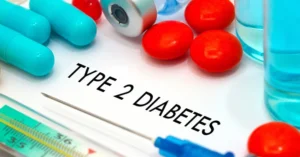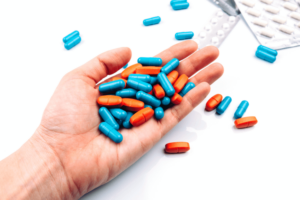Type 2 diabetes, a chronic condition affecting millions worldwide, requires diligent management and a deep understanding of the various treatment options available. In this comprehensive guide, we will explore the diverse landscape of type 2 diabetes medications used. We’ll delve into how these medications work, their benefits, potential side effects, and the latest advancements in diabetic care.
Contents
When To Consider Type 2 Diabetes Medications?
 When to consider medication for Type 2 diabetes is a critical decision that should be made in collaboration with a healthcare provider. It typically depends on several factors:
When to consider medication for Type 2 diabetes is a critical decision that should be made in collaboration with a healthcare provider. It typically depends on several factors:
- Blood Sugar Levels
Medication is often considered when blood sugar levels cannot be controlled through lifestyle changes alone. Healthcare providers use a test called the Hemoglobin A1C to measure average blood sugar control over the past two to three months. If your A1C level is above the target set by your doctor (usually above 7% for most adults), medication might be recommended.
- Presence of Symptoms
If you are experiencing symptoms of high blood sugar, such as frequent urination, excessive thirst, fatigue, or blurred vision, medication might be necessary to bring these symptoms under control.
- Duration of Diabetes
For people who have had Type 2 diabetes for a longer period, the pancreas may not produce enough insulin. And medication might be needed to supplement or stimulate insulin production.
- Presence of Other Health Conditions
If you have other health issues, like high blood pressure or high cholesterol, your doctor may prescribe medication to manage these conditions along with diabetes, as they can contribute to your overall risk of cardiovascular disease.
- Patient Preferences and Concerns
The decision might also depend on personal preferences, concerns, and lifestyle considerations. Some patients might prefer to try more aggressive lifestyle modifications before starting medication, while others might want to start medication right away.
Overall, the decision to start Type 2 diabetes medication is personalized and based on multiple factors. Regular consultation with a healthcare provider is essential to determine the most appropriate treatment plan.
What Are Some Type 2 Diabetes Medications?
 Type 2 diabetes medications are diverse, and they work in different ways to manage blood sugar levels. Here are some common categories and examples:
Type 2 diabetes medications are diverse, and they work in different ways to manage blood sugar levels. Here are some common categories and examples:
Metformin
Metformin is often the go-to initial treatment for Type 2 diabetes. It primarily works by decreasing the amount of glucose produced by the liver and by improving the body’s sensitivity to insulin. Thus enhancing the effectiveness of the insulin your body produces naturally. This dual-action approach helps to control blood glucose levels without causing significant weight gain. This is a common concern with some other diabetes medications.
Sulfonylureas
Drugs such as glipizide, glyburide, and glimepiride fall into this category. They work by stimulating the pancreas to produce more insulin, a key hormone that helps regulate blood sugar levels. By increasing insulin production, sulfonylureas help lower blood sugar levels. However, a significant downside of these medications is the risk of hypoglycemia, especially if meals are skipped or delayed, or if combined with other blood glucose-lowering medications.
Meglitinides
This class of drugs, which includes repaglinide and nateglinide, also stimulates the pancreas to produce more insulin. Similar to sulfonylureas, they are effective in reducing blood sugar levels but are faster-acting and have a shorter duration of action. This means they are typically taken before meals to control the rise in blood sugar that follows eating. Meglitinides can be particularly useful for people who have unpredictable meal schedules as they allow more flexibility.
Thiazolidinediones
Pioglitazone and rosiglitazone are examples of thiazolidinediones. These medications work by improving the sensitivity of body tissues to insulin, allowing more glucose to be absorbed by muscle and fat cells and less by the liver. This results in a lower level of glucose in the blood. While effective, these medications have fallen out of favor somewhat due to concerns about side effects. Nonetheless, for some individuals, particularly those with strong insulin resistance, they can be a valuable part of a diabetes treatment regimen.
DPP-4 inhibitors
Sitagliptin, saxagliptin, and linagliptin belong to this newer class of diabetes medications. DPP-4 inhibitors work by blocking the action of an enzyme called dipeptidyl peptidase-4 (DPP-4). This enzyme normally breaks down hormones called incretins. This helps to stimulate the production of insulin and suppress the release of glucagon (a hormone that raises blood glucose) following meals. By inhibiting this enzyme, DPP-4 inhibitors extend the action of incretins, leading to more prolonged insulin secretion and a reduction in blood glucose levels.
GLP-1 Receptor Agonists
These are a relatively newer class of injectable medications that play a significant role in Type 2 diabetes management. Drugs like exenatide (Byetta, Bydureon), liraglutide (Victoza), and semaglutide (Ozempic) belong to this category. They work by mimicking the action of the incretin hormone GLP-1, which is naturally produced in the gut. When blood sugar levels rise, GLP-1 receptor agonists stimulate the pancreas to produce more insulin.
SGLT2 Inhibitors
SGLT2 inhibitors, such as canagliflozin (Invokana), dapagliflozin (Farxiga), and empagliflozin (Jardiance), offer a unique approach to managing Type 2 diabetes. These oral medications work by blocking the sodium-glucose cotransporter 2 (SGLT2) in the kidneys. This inhibition results in the reduction of glucose reabsorption in the kidney, leading to increased excretion of glucose in the urine. Consequently, blood sugar levels drop. Beyond their glucose-lowering effect, SGLT2 inhibitors have garnered attention for their cardiovascular and renal benefits.
Insulin Therapy
For some people with Type 2 diabetes, insulin therapy is essential, especially when other medications do not adequately control blood sugar levels. Insulin comes in various forms, differing in how quickly it starts to work and how long its effects last. Types include rapid-acting insulin, which starts to work within minutes and is taken before meals; short-acting insulin, with a slightly longer onset; intermediate-acting insulin, covering insulin needs for about half the day or overnight; and long-acting insulin, which provides steady insulin levels throughout the day.
Combination Medications
In the treatment of Type 2 diabetes, combination medications have become increasingly popular. These oral medications blend two different types of diabetes drugs in one pill. Examples include metformin combined with a sulfonylurea (like glyburide) or with a DPP-4 inhibitor (like sitagliptin). The rationale behind combination therapy is to utilize the complementary mechanisms of different drugs to better control blood sugar levels. This approach can be more convenient, reducing the number of pills a person needs to take and often improving adherence to the treatment regime.
It’s important to note that the choice of medication depends on individual factors like blood sugar levels, any other health problems, and personal preferences. Also, new medications are continually being developed, so this list may evolve. Always consult a healthcare provider for personalized advice and treatment.
What Are The Side Effects To Consider?
 When considering the treatment of Type 2 diabetes with medications, it’s important to be aware of potential side effects. These side effects can vary depending on the specific medication, but there are common ones associated with different classes of diabetes drugs. Here are some general side effects to consider:
When considering the treatment of Type 2 diabetes with medications, it’s important to be aware of potential side effects. These side effects can vary depending on the specific medication, but there are common ones associated with different classes of diabetes drugs. Here are some general side effects to consider:
Gastrointestinal Issues
Some diabetes medications can cause gastrointestinal discomfort, including nausea, vomiting, diarrhea, and constipation. These symptoms are often most pronounced when beginning a new medication and may lessen over time.
Hypoglycemia (Low Blood Sugar)
Certain medications that increase insulin production or enhance its effectiveness can sometimes lead to low blood sugar levels, a condition known as hypoglycemia. Symptoms of hypoglycemia include dizziness, sweating, confusion, and in severe cases, loss of consciousness.
Weight Changes
Weight gain or loss can occur with various diabetes medications. Some drugs tend to promote weight gain, while others might contribute to weight loss. This is an important factor to consider, especially since weight management is a key part of diabetes care.
Skin Reactions
Some medications can cause skin reactions, such as rashes, itching, or redness. These reactions are usually mild but can be bothersome.
Edema (Fluid Retention)
Certain diabetes medications can cause the body to retain fluid, leading to swelling in the extremities. This can be uncomfortable and may exacerbate heart or kidney problems.
Respiratory Infections
Some drugs have been associated with an increased risk of respiratory infections, including sinus infections and sore throat.
Genitourinary Infections
Some classes of diabetes medications can increase the risk of urinary tract and genital infections.
Changes in Blood Lipid Levels
Certain diabetes medications can affect cholesterol and triglyceride levels, necessitating regular monitoring of blood lipid profiles.
Dizziness and Fatigue
Some patients may experience dizziness or fatigue as a side effect of their diabetes medication, which can impact daily activities.
Appetite Changes
Some medications can affect appetite, either increasing or decreasing it, which might require adjustments in diet.
It’s crucial to discuss the potential side effects of any medication with a healthcare provider. They can guide how to manage these effects and make adjustments to the treatment plan if necessary. Additionally, regular monitoring and follow-up appointments are key to ensuring that the benefits of the medication outweigh any adverse effects.
Conclusion
In conclusion, Type 2 diabetes medications are available but they have their potential side effects. From oral medications like metformin to injectable options such as insulin and GLP-1 receptor agonists, each treatment offers unique benefits and carries specific considerations. Common side effects like gastrointestinal discomfort, changes in weight, and the risk of hypoglycemia are important to keep in mind.
The decision on which medication to use should be made in close consultation with a healthcare provider, considering individual health needs, lifestyle factors, and personal preferences. Do you want to get rid of diabetes? Join our online diabetes treatment program and reverse Diabetes naturally through lifestyle changes such as a Personalized Diet plan, Exercise, Yoga, dieticians, and health coaches.

